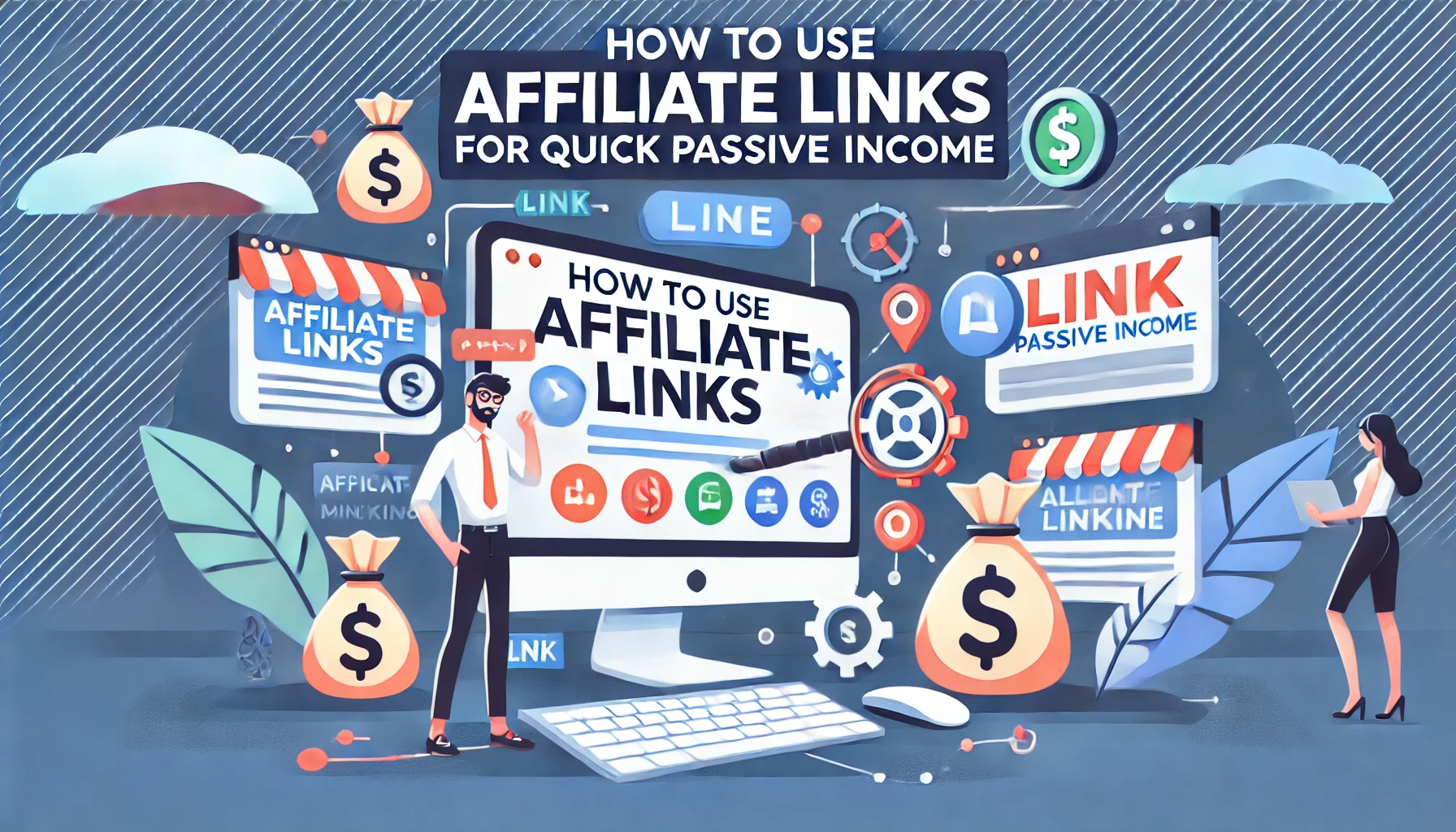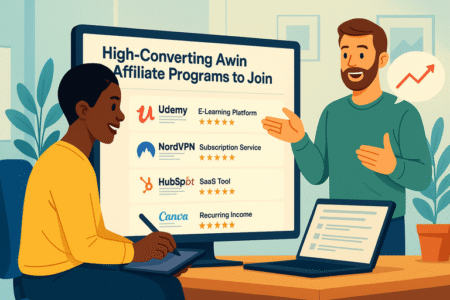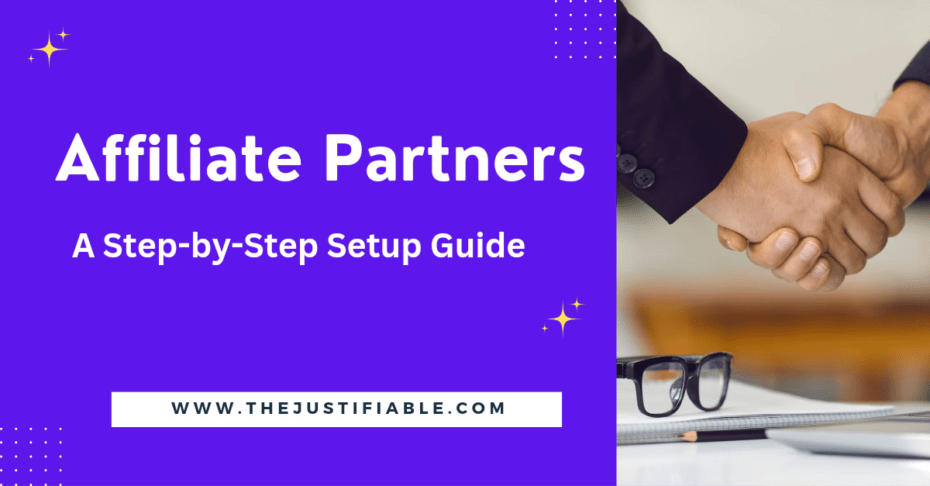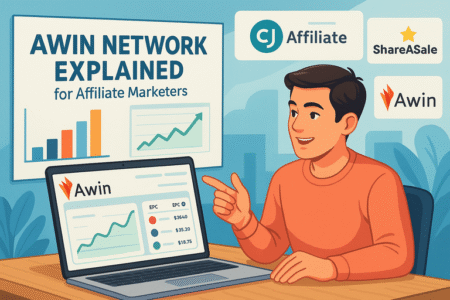Table of Contents
Are you interested in generating quick passive income with minimal upfront investment? Using affiliate links can be a powerful tool to start earning effortlessly by promoting products and services you believe in.
This guide will answer key questions about how to use affiliate links effectively, showing you strategic ways to incorporate them into your content, maximize earnings, and optimize for long-term passive income.
Understanding Affiliate Links And Passive Income Potential
Affiliate links are a powerful tool for generating passive income. By promoting products through these links, you earn commissions on sales without holding inventory or handling transactions. Understanding how affiliate links work is key to creating a sustainable income stream.
What Are Affiliate Links? A Beginner’s Guide
Affiliate links are unique URLs provided by companies that track sales generated through your referrals. When someone clicks on your link and makes a purchase, you earn a commission. This system allows you to promote products you trust while generating income.
Affiliate links make it easy to start earning by simply sharing content with your audience. Each click or sale through your link earns you a percentage, creating income without requiring extensive product knowledge. These links are a low-barrier entry to digital marketing.
I recommend using affiliate links within content that offers value, such as product reviews or guides. This approach builds trust and encourages readers to click through, increasing your earning potential with each shared link. It’s an accessible way to earn passively.
How Affiliate Links Generate Passive Income
Affiliate links generate passive income by allowing you to earn commissions on sales made through your links. Once embedded in your content, these links can bring in consistent earnings without constant updates, making it a flexible income source.
Using affiliate links strategically can create a steady revenue stream. Whether you’re blogging or creating social media posts, once your content is live, it works around the clock, converting clicks to sales. This hands-off approach appeals to many seeking passive income.
I believe consistency is crucial here. Regularly creating content with affiliate links increases visibility and reach, helping you earn more over time. The more valuable content you produce, the greater the chances of boosting passive income from affiliate marketing.
Why Affiliate Links Are Ideal For Passive Income
Affiliate links are ideal for passive income due to their scalability and flexibility. They allow you to earn with minimal ongoing effort, as one well-placed link can continue to bring in revenue long after it’s published.
This type of income model is perfect for those seeking flexibility. With affiliate links, you’re not tied to a specific schedule, letting you work at your own pace. You only need to create content once, allowing for ongoing returns with little maintenance.
I suggest affiliate links for anyone wanting to build a low-maintenance income stream. They suit bloggers, influencers, and website owners looking to monetize traffic with minimal investment, making them an effective way to supplement income consistently.
Key Benefits of Using Affiliate Links
Affiliate links offer key benefits like low startup costs, flexibility, and potential for consistent income. You don’t need inventory or customer service skills, making it accessible for anyone interested in earning through online promotions.
One of the major benefits is that affiliate links can adapt to different content types, from blogs to social media. This versatility makes it easy to integrate links into various content formats, allowing you to reach a wide audience and maximize profits.
I advise focusing on products and services that align with your niche. By promoting relevant items, you build credibility with your audience, which can increase engagement and trust, leading to better conversion rates and enhanced earnings.
Setting Up Affiliate Links For Maximum Earnings

Setting up affiliate links for maximum earnings involves choosing the right programs, understanding your audience, and strategically placing links. These steps help you optimize income potential by aligning your promotions with your audience’s interests.
Choosing High-Converting Affiliate Programs
Choosing high-converting affiliate programs is crucial to earning well. Look for programs that offer quality products, competitive commissions, and reliable tracking. Programs with high conversion rates often yield better returns for each link you promote.
Affiliate programs with recurring commission options are especially valuable, allowing you to earn on each customer’s renewal or repurchase. This structure offers an ongoing income from a single referral, which can be a significant advantage.
I recommend researching each program’s terms before joining. Check their commission structure, cookie duration, and payment schedule to ensure they align with your goals. Selecting quality programs increases the likelihood of higher conversions and earnings.
How To Identify Profitable Niches For Affiliate Links
Identifying profitable niches for affiliate links can increase your chances of success. Consider niches with strong demand, low competition, and high-ticket items, as these offer the potential for substantial commissions with each sale.
Conducting market research helps in finding niches where audiences are actively seeking products. For example, health, finance, and technology are profitable niches that attract motivated buyers. Focusing on such niches increases your link’s earning potential.
I suggest choosing a niche that aligns with your interests and knowledge. Promoting products you genuinely understand can enhance your content’s quality, making your recommendations more convincing and boosting your affiliate link’s effectiveness.
Setting Up Your Affiliate Accounts: Step-By-Step
Setting up affiliate accounts is simple but requires a few key steps. Start by choosing reputable affiliate platforms and applying for programs that align with your content. Once accepted, you’ll receive unique links to promote each product or service.
Most platforms provide a dashboard to track earnings, clicks, and conversions. Familiarize yourself with these tools, as they’ll be essential in monitoring and optimizing your affiliate link performance. This knowledge helps in refining your strategy over time.
I advise setting up payment details and understanding each platform’s payout policies. Different programs have various payout minimums and schedules, so make sure you’re clear on these aspects to plan your earnings effectively and avoid surprises.
Essential Tools For Managing Affiliate Links
Managing affiliate links effectively can improve your success. Use tools like link shorteners, tracking software, and analytics to optimize link performance, as they allow you to monitor clicks and conversions, providing insights into what’s working.
A popular tool is Google Analytics, which helps track traffic sources and conversion rates. Understanding where your clicks come from and what content drives engagement can guide your future strategies, making it easier to refine your approach.
I recommend using tools like Pretty Links or ThirstyAffiliates, which help organize, track, and cloak affiliate links. These tools enhance your professionalism and allow you to test which links perform best, maximizing earnings potential.
Where To Place Affiliate Links For Best Results
Strategic placement of affiliate links boosts their visibility and effectiveness. Placing links where readers are most likely to click, such as in blogs, social media, emails, and videos, maximizes your potential earnings with minimal effort.
Embedding Affiliate Links In Blog Content Effectively
Embedding affiliate links within blog content can drive substantial income if done thoughtfully. Links placed within product reviews, tutorials, or resource pages often see higher engagement as they provide helpful information that encourages readers to click through.
Placing links naturally within paragraphs makes them more likely to attract clicks. Readers are drawn to content that feels authentic, so I suggest only linking to products genuinely relevant to the topic. This builds trust and increases link effectiveness.
Consider using both text and image links within the blog. Images draw attention and can increase click-through rates. I recommend linking images directly to affiliate products, as this offers readers multiple ways to engage with your content and click.
Optimizing Affiliate Links For Social Media Platforms
Social media platforms are ideal for promoting affiliate links, especially with visually engaging content. Posts, stories, and reels on Instagram or TikTok, for instance, are perfect for direct product recommendations and quick calls-to-action for users.
Creating content that naturally includes affiliate links without feeling promotional is key. For example, I suggest using captions that share personal experiences or testimonials. This makes the recommendation feel genuine and inspires followers to click the link.
To maximize reach, use platform features like hashtags or collaborations. This can amplify your post’s visibility, increasing the chances that more users will see and click on your affiliate links. An engaging social presence can significantly boost affiliate earnings.
How To Use Affiliate Links In Email Marketing
Email marketing allows you to share affiliate links directly with subscribers who already trust your content. Placing links within newsletters or targeted emails lets you reach people interested in your recommendations, increasing the likelihood of conversions.
Use emails to highlight specific products or offers that align with your audience’s interests. I recommend keeping your tone conversational and highlighting why you think the product is worth their attention. A personal touch can improve click-through rates.
Segmenting your email list can make affiliate links even more effective. Tailor content to different groups based on their interests or past interactions with your emails. This customization helps boost engagement, making each link placement more impactful.
Leveraging Video Content With Affiliate Links
Video content is incredibly powerful for showcasing products. Platforms like YouTube allow you to place affiliate links in video descriptions or on-screen, giving viewers an easy path to purchase while seeing the product in action. This method often leads to high engagement.
In-video mentions, where you verbally recommend a product, also work well. I believe mentioning why you love or use the product can create a genuine connection with viewers, which boosts the chances they’ll check the description link to learn more.
Optimizing video titles and descriptions with relevant keywords and links is key. This increases your video’s visibility in search results, driving more traffic to your affiliate links. Video-based content can thus offer a high return on your affiliate strategy.
Crafting Engaging Content That Promotes Affiliate Links

Creating engaging content that incorporates affiliate links naturally is crucial for success. Quality content attracts readers, builds trust, and inspires clicks, making your affiliate links more effective in generating passive income.
Writing Compelling Reviews To Boost Affiliate Earnings
Writing detailed, honest reviews builds credibility and encourages readers to consider the product seriously. Describe your personal experience, features, and benefits to create an informative piece that helps readers make an informed decision.
When possible, share any unique insights or benefits that set the product apart. This helps differentiate your review from others, increasing engagement and potential clicks on your affiliate link. Readers appreciate firsthand information that supports their purchasing choices.
I recommend addressing common questions or concerns within your review. Answering these helps ease doubts, guiding readers closer to a purchase decision. This balanced approach makes reviews more persuasive and enhances your affiliate link’s effectiveness.
Tips For Creating How-To Guides With Affiliate Links
How-to guides are perfect for embedding affiliate links as they offer practical, actionable advice. Linking to relevant products or tools within the guide lets readers see how these items fit into their solutions, adding real value to your content.
Break down each step clearly, including affiliate links where they naturally apply to the process. For instance, if you’re writing about home fitness, suggest relevant equipment with links. This placement feels natural and gives readers useful resources to follow through.
Visuals, like images or short videos, can make your guide even more engaging. I suggest linking visuals directly to products, creating a seamless experience for readers interested in buying. How-to guides are an excellent way to drive targeted affiliate traffic.
Using Comparison Posts For Affiliate Marketing Success
Comparison posts allow readers to weigh options before purchasing. By comparing products side-by-side, you help readers make an informed choice, which can increase the likelihood of clicks on your affiliate links as they consider the best option for them.
Structure your comparison around factors that matter most to your audience. For instance, if you’re comparing tech gadgets, focus on features, price, and user-friendliness. I recommend only including affiliate links for products you genuinely believe in.
Comparison posts offer a balanced perspective that readers appreciate, as they help demystify product choices. Concluding with a summary or recommendation gives readers confidence, often leading them to use your affiliate link to make a purchase decision.
Balancing Value and Promotion In Affiliate Content
Balancing value and promotion is key in affiliate content. Focusing too heavily on sales can put off readers, so aim to provide information, insights, or entertainment that naturally integrates affiliate links, keeping the content engaging and valuable.
Ensure that your affiliate links align with the content’s purpose and are helpful to readers. I believe that by prioritizing the reader’s experience, you’ll build trust and encourage more link clicks without seeming overly promotional.
Avoid placing too many links in one piece of content. Select a few high-quality links that provide value, and your readers will appreciate the sincerity, likely leading to more effective conversions.
Maximizing Earnings From Affiliate Links
To boost your affiliate income, focus on strategies that enhance visibility, click-through rates, and conversions. Implementing thoughtful techniques for each aspect can help you earn more from your affiliate marketing efforts with minimal added time or investment.
Tips To Increase Click-Through Rates On Affiliate Links
Increasing click-through rates (CTR) is essential for affiliate success. One effective tip is placing links in highly visible areas, such as at the beginning or end of your content, where readers are most likely to notice and click.
I suggest using clear, engaging calls to action (CTAs) that encourage clicks. Simple phrases like “Discover More” or “Try This Here” often entice readers to click on the affiliate link. Make these CTAs relevant to your content for better results.
Experimenting with link placements and formats can also boost CTR. For instance, text links within a paragraph or buttons can perform well. Finding the best combination for your audience’s preferences can make a significant difference in your CTR.
Optimizing Conversion Rates For Passive Income
Conversion rates measure how many clicks turn into actual sales, so optimizing them can increase earnings. A high-quality product page can make a big difference. I recommend working with affiliates who offer strong, trustworthy product pages.
Crafting content that pre-sells the product helps prepare readers for what they’ll find after clicking. When you describe benefits and features accurately, it raises reader expectations, making conversions more likely once they reach the affiliate’s site.
Consider adding user testimonials or case studies that show the product’s success. These can build trust, helping readers feel more confident about purchasing, which can lead to higher conversion rates and greater passive income from your affiliate links.
Advanced Techniques To Scale Your Affiliate Revenue
Advanced techniques like upselling and cross-promoting can increase your affiliate earnings. Upselling involves recommending upgraded or premium versions of products, while cross-promoting suggests complementary products, both of which enhance value for your audience.
To scale further, I suggest using retargeting ads to reach previous visitors who didn’t convert initially. This approach keeps the products you promote fresh in their minds and can nudge them towards completing a purchase, boosting your revenue.
Another effective strategy is implementing seasonal promotions around holidays or sales events. Promoting affiliate links during high-demand periods can drive more clicks and conversions, creating opportunities to maximize your affiliate revenue potential.
Using SEO Strategies To Boost Affiliate Link Visibility
SEO strategies can enhance affiliate link visibility, increasing traffic and potential earnings. Using relevant keywords helps rank your content higher, making it easier for people searching for specific products or guides to find and click your links.
Consider optimizing your title tags, meta descriptions, and alt tags with keywords. This not only improves visibility but also attracts more readers interested in the content. I find that well-optimized content can significantly improve affiliate performance.
Longer, detailed content often performs better in search results. By creating comprehensive guides and tutorials, you increase your chances of ranking well, which means more organic traffic and greater exposure for your affiliate links.
Avoiding Common Mistakes With Affiliate Links
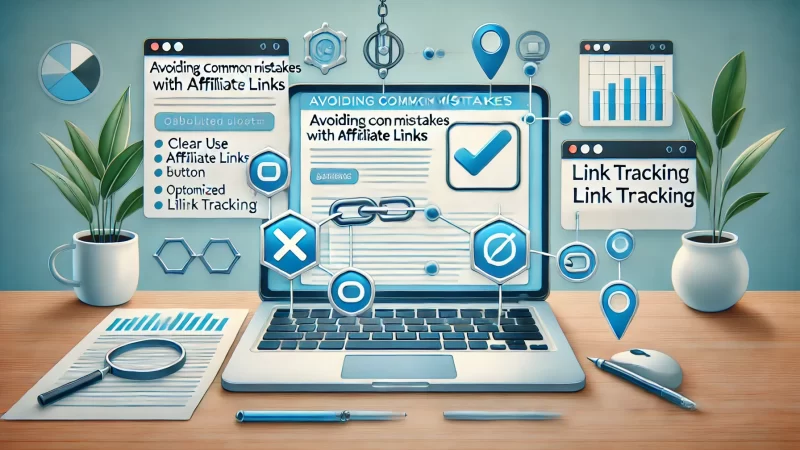
Avoiding common mistakes with affiliate links helps build trust and improve performance. Key pitfalls include over-promotion, compliance issues, and neglecting user experience, all of which can affect your earnings and credibility in affiliate marketing.
Overcoming Over-Promotion Pitfalls
Over-promotion can harm your credibility and deter readers from clicking links. Instead of filling content with links, focus on a few carefully chosen ones that provide real value. Readers appreciate sincerity, which often translates to more engagement.
Choose products or services that genuinely benefit your audience. I believe this approach strengthens your recommendations and encourages more authentic interactions, making readers more likely to trust and click on your links.
Another way to avoid over-promotion is to balance informative content with affiliate links. Offer insights, tips, or useful information that enriches the reader’s experience. When links feel relevant and valuable, they’re more likely to convert.
Common Compliance Issues With Affiliate Links
Staying compliant with affiliate marketing guidelines is essential. Be sure to disclose affiliate links, as transparency builds trust. I suggest using clear language like “This post contains affiliate links” at the beginning of your content to meet compliance standards.
Understanding platform policies also helps prevent issues. Different platforms like social media or blogs have unique disclosure requirements. Familiarizing yourself with these rules keeps your content aligned with each platform’s guidelines.
Avoid misleading claims about products, as they can lead to trust issues. Always provide accurate descriptions of affiliate products. This honesty ensures compliance and enhances the credibility of your recommendations, supporting a loyal audience.
How To Build Trust While Using Affiliate Links
Building trust with your audience is crucial when using affiliate links. One effective way is by recommending products you’ve personally tested or believe in, which shows readers you stand behind your recommendations and fosters a loyal relationship.
Personal stories or anecdotes add authenticity to your content, allowing readers to see why you’re recommending a product. I recommend sharing real experiences or insights, as they help connect with readers, making them more likely to trust your link.
Responding to audience feedback can also build trust. Engage with readers’ questions or comments about products, showing that you genuinely care about their experiences. This strengthens your relationship with your audience and improves affiliate link success.
Tracking Performance and Refining Your Strategy
Tracking the performance of your affiliate links provides valuable insights into what works. Using analytics tools can help you see which links attract the most clicks and conversions, making it easier to refine your strategy and improve your earnings.
Experimenting with different link placements, formats, and even products can reveal patterns in user behavior. I suggest testing these elements to identify the best-performing combinations, allowing you to optimize your approach over time.
Reviewing performance regularly also enables adjustments to maximize effectiveness. Fine-tuning based on analytics helps you stay responsive to trends and audience preferences, keeping your strategy sharp and your affiliate revenue growing.
Scaling Your Affiliate Income For Long-Term Success
Scaling your affiliate income requires strategic steps that expand your reach and revenue potential. Exploring new niches, analyzing data, and building authority can help you grow your affiliate income sustainably and effectively.
Expanding Into New Niches With Affiliate Links
Expanding into new niches allows you to reach wider audiences. Choose niches that align with your interests and where you can add value. I suggest targeting niches with strong demand, as they offer more opportunities for affiliate link engagement.
When exploring a new niche, build content that speaks to its unique audience. This targeted approach makes it easier to establish relevance and trust, leading to better engagement with your affiliate links in the new area.
Look for niches related to your current audience but that broaden your reach. For example, if you focus on health, expanding into fitness supplements can complement your existing content, allowing for cross-promotion and potentially more clicks.
Using Analytics To Guide Your Affiliate Strategy
Using analytics provides valuable insights to refine your affiliate strategy. Tracking key metrics like click-through rates, conversion rates, and revenue sources reveals which aspects of your approach are most effective, enabling smarter decision-making.
Identify which types of content drive the most traffic and revenue. I recommend using tools like Google Analytics to analyze visitor behavior, helping you understand what content resonates most with your audience and how to optimize affiliate placements.
Consistently reviewing analytics data lets you spot trends or shifts in performance. This allows you to make timely adjustments, aligning your strategy with what’s working best. Data-driven adjustments improve long-term success and maximize income potential.
Building Authority Sites For Passive Affiliate Income
Building an authority site in your niche establishes credibility and attracts a dedicated audience. Authority sites are seen as reliable resources, which can drive higher engagement and conversion rates for your affiliate links.
To create an authority site, focus on producing high-quality, informative content that genuinely helps readers. I believe consistency and authenticity are key here. As your site becomes a trusted source, it naturally attracts traffic and increases link clicks.
An authority site also opens up more revenue options, like direct partnerships or exclusive affiliate offers. As your reputation grows, these additional income streams can complement your affiliate earnings, enhancing your overall passive income strategy.
The Power Of Affiliate Networks And Partnerships
Joining affiliate networks and building partnerships can enhance your income opportunities. Networks provide access to a wide range of affiliate programs, helping you find reputable brands and products to promote across different niches.
Affiliate partnerships, where you collaborate with brands or other affiliates, can also be valuable. I suggest networking with others in your niche, as these relationships often lead to unique offers or higher commissions that increase your earnings.
Affiliate networks often offer tools for tracking and optimization, making it easier to manage your links. Leveraging these resources helps streamline your efforts, allowing you to focus on scaling your income with minimal added complexity.


